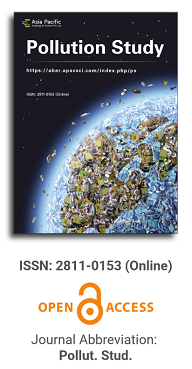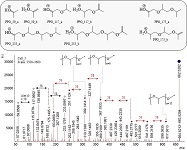
Asia Pacific Academy of Science Pte. Ltd. (APACSCI) specializes in international journal publishing. APACSCI adopts the open access publishing model and provides an important communication bridge for academic groups whose interest fields include engineering, technology, medicine, computer, mathematics, agriculture and forestry, and environment.

The (partial) replacement of synthetic polymers with bioplastics is due to increased production of conventional packaging plastics causing for severe environmental pollution with plastics waste. The bioplastics, however, represent complex mixtures of known and unknown (bio)polymers, fillers, plasticizers, stabilizers, flame retardant, pigments, antioxidants, hydrophobic polymers such as poly(lactic acid), polyethylene, polyesters, glycol, or poly(butylene succinate), and little is known of their chemical safety for both the environment and the human health. Polymerization reactions of bioplastics can produce no intentionally added chemicals to the bulk material, which could be toxic, as well. When polymers are used to food packing, then the latter chemicals could also migrate from the polymer to food. This fact compromises the safety for consumers, as well. The scarce data on chemical safety of bioplastics makes a gap in knowledge of their toxicity to humans and environment. Thus, development of exact analytical protocols for determining chemicals of bioplastics in environmental and food samples as well as packing polymers can only provide warrant for reliable conclusive evidence of their safety for both the human health and the environment. The task is compulsory according to legislation Directives valid to environmental protection, food control, and assessment of the risk to human health. The quantitative and structural determination of analytes is primary research task of analysis of polymers. The methods of mass spectrometry are fruitfully used for these purposes. Methodological development of exact analytical mass spectrometric tools for reliable structural analysis of bioplastics only guarantees their safety, efficacy, and quality to both humans and environment. This study, first, highlights innovative stochastic dynamics equations processing exactly mass spectrometric measurands and, thus, producing exact analyte quantification and 3D molecular and electronic structural analyses. There are determined synthetic polymers such as poly(ethylenglycol), poly(propylene glycol), and polyisoprene as well as biopolymers in bags for foodstuffs made from renewable cellulose and starch, and containing, in total within the 20,416–17,495 chemicals per sample of the composite biopolymers. Advantages of complementary employment in mass spectrometric methods and Fourier transform infrared spectroscopy is highlighted. The study utilizes ultra-high resolution electrospray ionization mass spectrometric and Fourier transform infrared spectroscopic data on biodegradable plastics bags for foodstuffs; high accuracy quantum chemical static methods, molecular dynamics; and chemometrics. There is achieved method performance |r| = 0.99981 determining poly(propylene glycol) in bag for foodstuff containing 20,416 species and using stochastic dynamics mass spectrometric formulas. The results highlight their great capability and applicability to the analytical science as well as relevance to both the fundamental research and to the industry.
Impact of reduced fertilizer application on the yield and non-point source pollution from Yongyou rice cultivation
Vol 3, Issue 1, 2022
Download PDF
Abstract
In the major grain production regions of China, agricultural non-point source pollution and the eutrophication of adjacent surface waters due to the excessive use of chemical fertilizers continue to be significant issues. To address the irrational traditional fertilization practices of farmers and to mitigate agricultural non-point source pollution, a fertilization reduction project was initiated in Jiangshan City. This project aimed to investigate the impact of reducing fertilizer application by 10% to 30% on the yield of Yongyou 15 rice variety and the loss of nutrients (total nitrogen, total phosphorus, and total potassium) in the surface runoff from paddy fields, relative to the farmers' standard fertilization practices. The findings indicated that reducing the conventional fertilizer dosage by 10% to 20% did not lead to a significant decrease in rice yield, with the yield being highest at a 10% reduction. Following fertilization, the nutrient concentration in the paddy field drainage rapidly reached a peak within one hour, after which nitrogen, phosphorus, and potassium concentrations decreased sharply by 25.9% to 66.0%, 70.1% to 88.3%, and 25.0% to 52.5%, respectively, within 24 hours. Subsequently, all nutrient levels continued to decline gradually until the end of the experiment. This suggests that the risk period for nutrient loss, which also corresponds to a high-risk period for non-point source pollution, occurs within a few days after fertilization, particularly if the paddy field is drained due to heavy rain or artificial means. The reduction in chemical fertilizer significantly influenced the nutrient content in the paddy field drainage. One hour after fertilization, reducing the conventional fertilization rate by 10% to 30% resulted in decreases in the concentrations of total nitrogen, total phosphorus, and total potassium in the drainage by 3.7% to 68.2%, 26.3% to 64.8%, and 5.8% to 57.5%, respectively. This approach holds significant potential for enhancing economic benefits and safeguarding the ecological environment in rice cultivation.
Keywords
References
- National Bureau of Statistics. 2019. Available online: Https://data.Stats.Gov.Cn/easyquery.Htm?Cn=C01 (accessed on 14 April 2020).
- Ma K, Diao G. Study on the contribution rate of chemical fertilizer to the change of grain yield in China. Journal of plant nutrition and fertilizer. 2018; 24(4): 1113-1120.
- Liu Y, Wang H, Jiang Z, et al. Genomic basis of geographical adaptation to soil nitrogen in rice. Nature. 2021; 590(7847): 600-605. doi: 10.1038/s41586-020-03091-w
- Zhang, Liu F, Hou T. Current situation of nitrogen and phosphorus loss in paddy fields and research progress of influencing factors in China. Journal of Applied Ecology. 2019; 30(10).
- Liu H, Guo Z, Jia J, et al. Effects of nitrogen fertilizer reduction on Rice Yield and nitrogen loss in Taihu region. Journal of ecology. 2017; 36(3): 713-718.
- Shen J, Ma W, Wang Z, et al. Effects of different slow and controlled release fertilizers on indica Japonica Hybrid Rice. Zhejiang agricultural science. 2017; 58(12): 2153-2156.
- Wang Q, Li F, Zhao L, et al. Effects of irrigation and nitrogen application rates on nitrate nitrogen distribution and fertilizer nitrogen loss, wheat yield and nitrogen uptake on a recently reclaimed sandy farmland. Plant and Soil. 2010; 337(1-2): 325-339. doi: 10.1007/s11104-010-0530-z
- Saeed U, Wajid SA, Khaliq T, et al. Optimizing irrigation and nitrogen for wheat through empirical modeling under semi-arid environment. Environmental Science and Pollution Research. 2017; 24(12): 11663-11676. doi: 10.1007/s11356-017-8733-y
- Shi C, Zhu J. Economic evaluation and analysis of chemical fertilizer input in grain production in China. Resources and environment in arid areas. 2016; 30(9): 57-63.
- Zhao Q, Li Y, Ma J, et al. Effects of different nitrogen and phosphorus levels on Rice Yield and fertilizer absorption and utilization in Nansihu region. Soil bulletin. 2011; 42(5): 1204-1208.
- Wang J, Fu P, Wang F, et al. Optimizing nitrogen management to balance rice yield and environmental risk in the Yangtze River’s middle reaches. Environmental Science and Pollution Research. 2018; 26(5): 4901-4912. doi: 10.1007/s11356-018-3943-5
- Yu Y, Xue L, Yang L. Effects of different nitrogen fertilizer management models on nitrogen leakage in paddy soil in Taihu Basin. Journal of soil. 2011; 48(5): 988-995.
- Qi D, Wu Q, Zhu J. Nitrogen and phosphorus losses from paddy fields and the yield of rice with different water and nitrogen management practices. Scientific Reports. 2020; 10(1). doi: 10.1038/s41598-020-66757-5
- Lawlor PA, Helmers MJ, Baker JL, et al. Nitrogen Application Rate Effect on Nitrate-Nitrogen Concentration and Loss in Subsurface Drainage for a Corn-Soybean Rotation. Transactions of the ASABE. 2008; 51(1): 83-94. doi: 10.13031/2013.24229
- Wang J, Fu Z, Chen G, et al. Runoff nitrogen (N) losses and related metabolism enzyme activities in paddy field under different nitrogen fertilizer levels. Environmental Science and Pollution Research. 2018; 25(27): 27583-27593. doi: 10.1007/s11356-018-2823-3
- Sun X, Liang X, Zhang F, et al. A GIS‐based Upscaling Estimation of Nutrient Runoff Losses from Rice Paddy Fields to a Regional Level. Journal of Environmental Quality. 2016; 45(6): 1865-1873. doi: 10.2134/jeq2016.05.0181
- Xi B, Zhai L, Liu, et al. Effects of combined application of organic and inorganic fertilizers on Maize Yield and soil nitrogen and phosphorus leaching. Journal of plant nutrition and fertilizer. 2015; 21(2): 326-335.
- Liu J, Ouyang X, Shen J, et al. Nitrogen and phosphorus runoff losses were influenced by chemical fertilization but not by pesticide application in a double rice-cropping system in the subtropical hilly region of China. Science of The Total Environment. 2020; 715: 136852. doi: 10.1016/j.scitotenv.2020.136852
- Lentz RD, Lehrsch GA. Nutrients in Runoff from a Furrow‐Irrigated Field after Incorporating Inorganic Fertilizer or Manure. Journal of Environmental Quality. 2010; 39(4): 1402-1415. doi: 10.2134/jeq2009.0374
Supporting Agencies
Copyright (c) 2022 Qian Mao, Jiangming Zhou

This work is licensed under a Creative Commons Attribution 4.0 International License.

This site is licensed under a Creative Commons Attribution 4.0 International License (CC BY 4.0).
.jpg)
Beijing University of Technology, China



